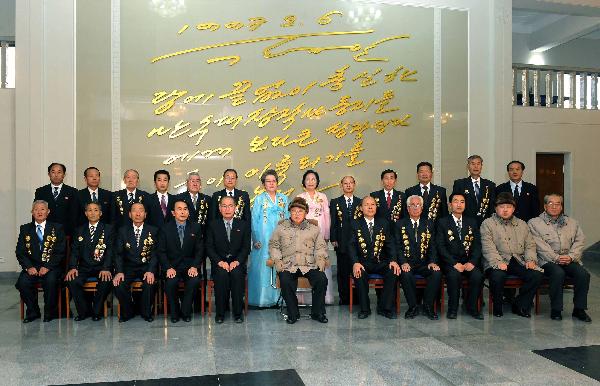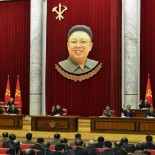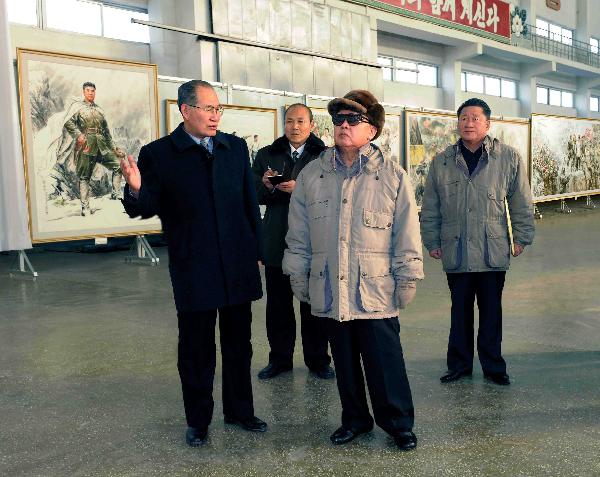Mansudae Art Studio

This photo released by official news agency KCNA of the Democratic People's Republic of Korea (DPRK) on Jan. 23, 2011, shows Kim Jong Il, top leader of the DPRK, inspects the Mansudae Art Troupe. (Xinhua/KCNA)
KCNA report from 22 January 2011:
Kim Jong Il Provides Field Guidance to Mansudae Art Studio
[KCNA, January 22, 2011]
Pyongyang – Kim Jong Il, general secretary of the Workers’ Party of Korea and chairman of the National Defence Commission of the DPRK, provided field guidance to the Mansudae Art Studio.
He looked round the statue of President Kim Il Sung newly erected in the compound of the studio. Then he went round the merited sculpture production unit and other places of the studio for hours to learn in detail about art creation.
Watching the newly created marble statues of the President, a peerlessly great man, he praised the unit for truthfully representing him in the same figure as what he used to be.
He went round Korean paintings, oil paintings, sculptures, metal craftworks and other pieces done creators of the studio.
The signal successes made by the studio are a clear proof of the validity and great vitality of the WPK’s Juche-oriented policy on art which calls for creating genuine art and making it serve as an effective ideological and educational means correctly reflecting the requirement of the times and the desire of the people and encouraging the working masses in the revolution and construction, he noted.
He also watched peculiar art pieces done by creators of other units. The art creation is brisk not only among experts but in the army and all fields of society, producing a lot of excellent works, he noted. This is the shining fruition of the rich cultural and emotional attainments of the Korean people with rare aesthetic sense, he added.
He underscored the need to display well the art pieces created by the studio so that people can always enjoy them as they are valuable treasures of national value.
He went round a modern cultural hall and the magnificent and elegant creation centers built by the studio itself, greatly satisfied to learn that the studio has turned into the nation’s leading art producer.
He noted that the party members and other working people of the studio created great many masterpieces, including Korean paintings, sculptures, embroideries, handicrafts, feats to be specially recorded in the history of art. He highly appreciated their feats and extended thanks to them.
He set forth tasks to be carried out to further develop the Juche-based art.
Calling upon the creators of the studio to actively develop art works of diverse genres and forms and create many peculiar art pieces with great ideological and artistic values and thus bring about a new turn in creating art works, he said: It is necessary to further develop Korean paintings to suit their characteristics as they have an important role to play in developing the nation’s art in a Juche-based way.
Korean paintings are done in the traditional art form of the Korean nation and by unique technique. It is necessary to direct particular efforts to doing Korean paintings by peculiar technique and preserving their characteristics as they are characterized by dynamic, graceful and noble art.
An oil painting is one of the art forms encouraged in many countries of the world and if the nation’s art is to be developed worldwide, it is necessary to channel due efforts to developing oil painting, a heritage of humankind.
The studio should steadily develop not only Korean paintings and oil paintings but jewel-powdered paintings, calligraphic works, embroideries, ceramic handicrafts and metal handicrafts in keeping with the need of the times and the aspiration of the people.
At the end of his field guidance, he enjoyed a performance given by the art squad of the studio together with its employees.
Accompanying him were Kim Jong Un, vice-chairman of the Central Military Commission of the WPK, Kim Ki Nam and Choe Thae Bok, members of the Political Bureau and secretaries of the C.C., the WPK, Kim Kyong Hui, member of the Political Bureau and department director of the C.C., the WPK, Choe Ryong Hae and Kim Phyong Hae, alternate members of the Political Bureau and secretaries of the C.C., and Mun Kyong Dok, alternate member of the Political Bureau and secretary of the C.C., the WPK and chief secretary of the Pyongyang City Committee of the WPK.

